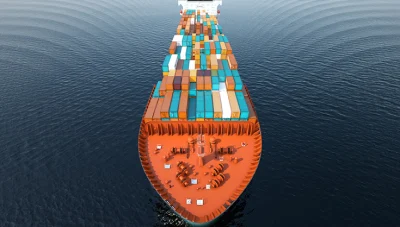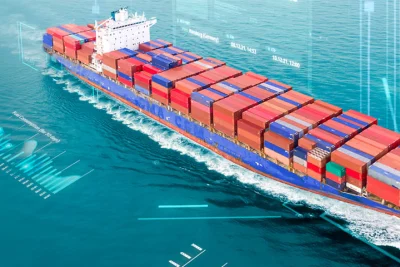Out of Box
Lloyd’s Register recently partnered with Thetius to publish a joint report discussing AI and Autonomy in the maritime industry. Titled Out of Box, the paper provides a comprehensive assessment of the current and potential use cases for AI and Autonomy in maritime, and highlights the importance of diligent assurance in how these technologies are implemented.
The report highlights the tremendous opportunities of AI and Automation in transforming how the maritime industry operates, while also emphasising the importance of developing, testing and continually assessing systems for safety and efficacy.
LR and Thetius estimate that both AI-driven systems and vessel autonomy markets will be worth a combined $5bn by 2028. Despite the vast potential for transformation in all areas of the maritime ecosystem, a certain degree of caution is still advised. Traditional assurance measures should be increasingly integrated, and technology should be appropriate to user risks. The report also recommends the creation of an independent cross-industry body to support the safe development of artificial intelligence for maritime organisations.
AI & Autonomy
The report highlights the notable growth of both AI and Autonomy markets in the maritime industry, with significant investments and developments expected to continue. While there is an overlap of organizations operating in these domains, such as the common use of AI to power Autonomy, the two concepts are distinct.
AI (Artificial Intelligence) refers to the use of computer algorithms to perform tasks that typically require human intelligence, such as decision-making, problem-solving, and pattern recognition. AI can be used to enhance the performance of various maritime operations, including navigation, logistics, and vessel maintenance.
On the other hand, Autonomy refers to the ability of vessels to operate without human intervention. Autonomous vessels are capable of performing various tasks, such as navigation, collision avoidance, and cargo handling, using a combination of sensors, machine learning algorithms, and other technologies.
Both AI and Autonomy can be used to enhance and improve various maritime operations by leveraging computer algorithms and machine learning to perform tasks that typically require human intelligence and enable vessels to operate without human intervention.
The convergence of AI and Autonomy in the maritime industry is creating a combined market worth $3.36 billion with an 11% overlap. The markets are expected to continue to converge and be worth $5.01 billion by 2028, complementing each other’s strengths. However, the markets differ in SME and corporate representation, with government bodies being absent in AI initiatives but contributing significantly to Autonomy. This suggests slow government regulation and enablement of these fast-paced technology sectors.
Determining the business case
The report expands on the process of building a solid business case for AI and Autonomy investments and the requirement of a comprehensive understanding of various factors in the decision-making process.
These factors include evaluating the core ROI on asset investment, examining the equipment and systems needed for different applications, understanding how AI and Autonomy impact both shoreside operations and ship performance, and identifying actual or potential reductions in environmental harm. Decision makers must weigh economic, technological, operational, and environmental aspects when deciding to invest in these cutting-edge technologies.
The example of voyage optimisation

In recent years, AI-powered voyage optimisation has become increasingly prevalent in the maritime industry as shipping companies seek to improve efficiency, reduce costs and mitigate risk.
AI-powered voyage optimisation involves analysing vast amounts of data related to a ship’s route, weather conditions, fuel consumption, cargo capacity, and other factors using advanced algorithms and machine learning techniques. To ensure accuracy, the algorithm considers a range of variables such as detailed weather forecasts, unique vessel parameters, compliance requirements, scheduling, fuel performance, cargo needs and environmental regulations.
Consolidating these requirements into a synthesised, AI-powered algorithm saves time and reduces human error, particularly for navigational crew, who are often tasked with planning routes on short notice. In this instance, AI provides the agility to react to unfolding voyage requirements in a timely manner without compromising on safety.
AI-powered voyage optimisation complements the four-step passage planning process mandated by the IMO by providing more accurate and up-to-date information for each step, such as real-time weather data, simulations and route optimisation recommendations tailored to the unique characteristics of the vessel and its cargo.
Through this process, AI-powered voyage optimisation can create a standardized approach to voyage planning, ensuring that all vessels within a fleet, or subsection of a fleet, follow the same formula for optimisation. This approach also allows for greater consistency in how company policies with regards to safety and compliance are followed, allowing shoreside decision-makers to better evaluate vessel performance against the same criteria.
Operating with assurance
Developing and ensuring the safety of AI and Autonomy driven systems aboard modern vessels is a complex process that requires the expertise of experienced engineers, rigorous testing and assurance measures.
Classification societies play an essential role in facilitating the safe adoption of innovative digital solutions. LR is continually adapting its assurance processes to accommodate emerging innovations. This will enable new technologies to be used optimally while upholding high levels of safety throughout maritime operations.

